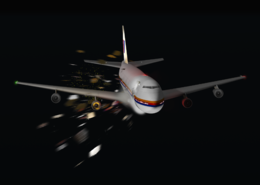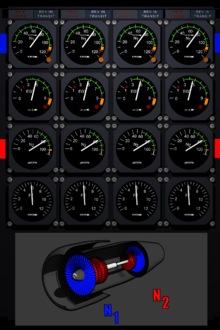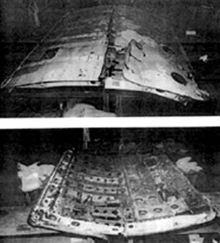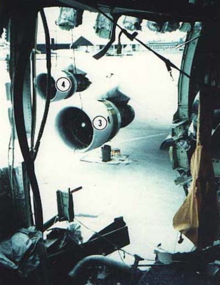- United Airlines Flight 811
-
United Airlines Flight 811 
Illustration of Flight 811 just after decompressionAccident summary Date February 24, 1989 Type Explosive decompression
(Cargo door design flaw and failure)Site Pacific Ocean
near Honolulu, HawaiiPassengers 337 Crew 18 Injuries 38 Fatalities 9 Survivors 346 Aircraft type Boeing 747-122 Operator United Airlines Tail number N4713U Flight origin San Francisco International Airport, San Francisco, United States 1st stopover Los Angeles International Airport, Los Angeles, United States 2nd stopover Honolulu International Airport, Honolulu, United States Last stopover Auckland Airport, Auckland, New Zealand Destination Sydney Airport, Sydney, Australia United Airlines Flight 811 experienced a cargo door failure in flight on Friday, February 24, 1989, after its stopover at Honolulu International Airport, Hawaii. The resulting decompression blew out several rows of seats, killing 9 passengers.
The aircraft involved was a Boeing 747-122 (c/n 19875/89, reg N4713U), delivered to United Airlines on October 20, 1970.
Contents
Incident
Flight 811 took off from Honolulu International Airport bound for Auckland, New Zealand with 3 flight crew, 15 flight attendants, and 337 passengers at approximately 01:52 HST.[1] Its flight crew consisted of Captain David Cronin, First Officer Al Slader and Flight Engineer Mark Thomas.
During the climb, the crew made preparations to detour around thunderstorms along the aircraft's track; anticipating turbulence, the captain kept the seat-belt sign lit. Around this time (02:08) the plane had been flying for approximately 16 minutes and was passing between 22,000 and 23,000 feet (6,700–7,000 m). In the business-class section, a grinding noise was heard, followed by a loud thud which rattled the whole aircraft — 1½ seconds later the forward cargo-door blew out abruptly. The pressure differential caved in the main cabin floor above the door, causing ten seats (8G&H through 12G&H) and an individual seated in 9F to be ejected from the cabin, resulting in nine fatalities (seats 8G and 12G were empty) and leaving a gaping hole in the aircraft.[1] The fatalities were: Anthony and Barbara Fallon, Harry and Susan Craig, Lee Campbell, Dr. J Michael Crawford, John Swan, Rose Harley and Mary Handley-Desso.[2] Mae Sapolu, a flight-attendant in the Business-Class cabin, was almost pulled out of the plane, but was seen by passengers and fellow crew clinging to a seat leg; they were able to pull her to safety inside the cabin, although she was severely injured. The pilots began an emergency descent to get the aircraft rapidly down to breathable air, while performing a 180-degree left turn to take them back to Honolulu. The decompression had damaged components of the on-board emergency oxygen supply system, which is primarily located in the forward cargo sidewall area, just aft of the cargo door.[3]
The debris ejected from the plane during the explosive decompression caused severe damage to the number 3 and 4 engines, causing visible fires in both. The crew did not get fire warnings from either of them, although engine 3 was experiencing heavy vibration, no N1 reading, and low EGT and EPR, leading the crew to deactivate it. At 02:10, an emergency was declared, and the crew began dumping fuel to get the plane's weight down to an acceptable landing weight. Initially, they pushed the number 4 engine slightly to help force the plane down faster, but once they noticed it was giving almost no N1, high EGT, and was emitting flames, they shut it down also. Some of the explosively ejected debris damaged the right wing's LEDs (Leading Edge Devices), dented the horizontal stabilizer on that side, and even struck the tailfin. NTSB reports found human remains in the fan blades of Number 3 engine, bringing a cold comfort that some of the victims died almost instantly as they were pulled out of the plane.[2]
During the descent Captain Cronin had ordered Flight Engineer Randal Thomas to tell the flight attendants to prepare for an emergency landing, but he was unable to contact the flight attendants. Thomas asked the captain if he could go down and find out what was happening. Cronin agreed. Thomas saw severe damage immediately upon leaving the cockpit: the aircraft's skin was peeled off in some areas on the upper deck revealing the frames and stringers. As he went down to the lower deck the magnitude of the damage became obvious as he now saw the gigantic hole in the side of the plane. Thomas came back to the cockpit, visibly pale, and reported that large section of fuselage aft of the Number 1 exit door was open. He concluded that it was probably a bomb, and considering the condition of the plane, it would be unwise to exceed 250 knots (460 km/h). The plane's stall speed was around 240 knots (440 km/h), producing a narrow operating envelope.[3]
As the plane neared the airport, the landing gear was extended. The flaps were only partially deployed, as a result of damage sustained following the decompression. This resulted in a landing speed between 190–200 knots (350–370 km/h). Regardless, Captain Cronin was able to get the plane to a halt without going off the end of the runway. Fourteen minutes had elapsed since the emergency was declared.[3] Evacuation was carried out and all passengers and flight attendants were off in less than 45 seconds, though every flight attendant suffered some injury during the evacuation, ranging from scratches to a dislocated shoulder.[1]
Cause
The accident was most likely caused by improper wiring and deficiencies in the door's design. Unlike a plug door which opens inwards and essentially jams against its frame as the pressure outside drops, the Boeing 747 was designed with an outward-hinging door which, while increasing capacity, required a locking mechanism to keep the door closed. Deficiencies in the design of wide-body aircraft cargo doors were already known since the early 1970s from flaws in the DC-10 cargo door.[4][5] Despite the warnings and deaths from the DC-10 incidents, and early Boeing attempts to solve the problems in the 1970s, the problems were not seriously addressed by the aircraft industry until much later.[6]
The 747's cargo door utilized a series of electrically-operated latch cams with which the latch pin locks in, the cam then rotating into the closed position. A series of L-shaped arms called locking sectors, actuated by the moving of a lever to close the door, are designed to reinforce the latch cams and prevent them from rotating into the unlocked position. The locking sectors were made out of aluminum, and of too thin a gauge to be able to keep the latch cams from moving into the unlocked position against the power of the door motors. If an electrical switch designed to cut electrical power to the cargo door when the outer handle was closed was faulty; the motors could still draw power. It appeared in this case that a short circuit in the aging plane caused an uncommanded rotation of the latch cams, which forced the weak locking sectors to unlock; the pressure differential and aerodynamic forces then blew the door off the fuselage, causing the massive decompression.[3]
Personal investigation
Lee Campbell, a native New Zealander returning home, was one of the casualties on Flight 811. After his death his parents, Kevin and Susan Campbell, investigated the cause of the decompression independently of the National Transportation Safety Board. The Campbells' investigation led them to conclude that the design of the aircraft's cargo door latching mechanism was flawed.[7]
As early as 1975, Boeing realized the aluminum locking sectors were of too thin a gauge to be effective and recommended the airlines add doublers to the locking sectors. In 1987 Pan Am Flight 125 outbound from London Heathrow Airport encountered pressurization problems at 20,000 feet (6,100 m), causing the crew to abort the flight and return to the airport. After the safe landing, the aircraft's cargo door was found to be ajar by about 1.5 inches (3.8 cm) along its ventral edge. When the aircraft was examined in a maintenance hangar, all of the locking arms were found to be either damaged or sheared off entirely. Boeing initially attributed this to mishandling by ground crew. To test this concern, Boeing instructed 747 operators to shut and lock the cargo door with the external handle, and then activate the door-open switch with the handle still in the locked position. Since the S-2 switch was designed to deactivate the door motors if the handle was locked, nothing should have happened. Some of the airlines reported the door motors did indeed begin running, attempting to force the door open against the locking sectors and causing damage to the mechanism.[3]
Prior to the Flight 811[when?] incident Boeing issued a Service Bulletin notifying operators to replace the aluminum locking sectors with steel locking sectors, and carry out various inspections. In the United States, the FAA mandated this service by means of an Airworthiness Directive (AD) and gave US-flag airlines 18 months to comply with the AD. After the Flight 811 incident, the FAA shortened the time to 30 days.[3]
In 1991, an incident occurred at New York's John F. Kennedy International Airport involving the malfunction of a United Airlines Boeing 747 cargo door.[8] At the time, United Airlines' maintenance staff were investigating the cause of a circuit breaker trip. In the process of diagnosing the cause, an inadvertent operation of the electric door latch mechanism caused the cargo door to open spontaneously. This incident led to latch damage similar to that observed on the cargo door of Flight 811.
Two pieces of the Flight 811 cargo door were recovered from the Pacific Ocean on September 26, 1990 and October 1, 1990.
Outcomes
The NTSB issued a recommendation for all 747-100s in service at the time to replace their cargo door latching mechanisms with new, non-faulty locks.[9] A sub-recommendation suggested replacing all outward-opening doors with inward-opening doors, which cannot open in flight due to the pressure differential. No similar fatality-causing accidents have officially occurred on this aircraft type, although other investigations indicate the possibility that other old Boeing 747s were afflicted.[10]
In 1989, the flight crew received the Secretary's Award for Heroism for their actions.[11] United Airlines ran a simulation through a flight simulator and were, despite many attempts and variable tweaks, unable to successfully land a plane after losing the forward cargo door.[12]
The aircraft was successfully repaired, re-registered as N4724U in 1989, and returned to service with United Airlines in 1990. In 1997, the aircraft was registered with Air Dabia as C5-FBS,[13] but abandoned in 2001 during overhaul maintenance at Plattsburgh International Airport.[14] The plane was broken up for parts in 2004.[15]
Dramatization
The story of the disaster was featured on the first season of Canadian National Geographic Channel show Mayday (known as Air Emergency in the US, Mayday in Ireland and Air Crash Investigation in the UK and the rest of world). The episode is entitled "Ripped Apart" (Air Crash Investigation: "Unlocking Disaster").
See also
- American Airlines Flight 96 Cargo door malfunction
- Turkish Airlines Flight 981 Cargo door malfunction
- Pan Am Flight 125 Cargo door malfunction
- Swissair Flight 111 Known malfunction not fixed
- Alaska Airlines Flight 261 Known malfunction not fixed
- TWA Flight 800 Known malfunction not fixed
- Air France Flight 447 Known malfunction not fixed
References
- ^ a b c AAR92-02 NTSB report
- ^ a b http://www.airlinecrew.net/vbulletin/showthread.php?t=209818
- ^ a b c d e f "Unlocking Disaster." Mayday. Cineflix Productions. Aired Discovery Channel Canada, 2003.
- ^ Moira Johnston. "The Last Nine Minutes: The Story of Flight 981". pp. Page 29 Image. http://www.montereypeninsulaairport.com/DC-10page29.html. Retrieved December 3, 2008.
- ^ Moira Johnston. "The Last Nine Minutes: The Story of Flight 981". pp. Google Books Search on '747'. http://books.google.com/books?id=LWkvAAAAMAAJ&dq=068803084X&q=747&pgis=1#search. Retrieved December 3, 2008.
- ^ http://cset.sp.utoledo.edu/engt2000/Lesson11.pdf
- ^ Judith Valente (1990-02-27). "Roots Of Tragedy -- Parents Seek Reasons For Death Of Son". Wall Street Journal. http://community.seattletimes.nwsource.com/archive/?date=19900227&slug=1058277. Retrieved 2009-06-24.
- ^ NTSB Safety Recommendation A91-84 & 84, August 28, 1991
- ^ Aircraft Accident Report Number AAR-92/02 Executive Summary, National Transportation Safety Board.
- ^ http://www.ntsb.org/Wiringcargodoorlite/home_files/SmithAAR182.pdf
- ^ Honoring the Crew of United Airlines Flight 811, House of Representatives, Page H1798, May 10, 1989, Retrieved from the Library of Congress.
- ^ Eyewitness Report:United 811, Eyewitness account on airdisaster.com
- ^ "Air Dabia C5-FBS (Boeing 747) (Ex N4713U N4724U )". Airfleets. http://www.airfleets.net/ficheapp/plane-b747-19875.htm. Retrieved 2009-05-18.
- ^ "Photo Air Dabia Boeing 747-100 C5-FBS". Planepictures.net. 2009-02-24. http://www.planepictures.net/netshow.php?id=5451. Retrieved 2009-05-18.
- ^ "What Happened To UA Flight 811 Airframe? Civil Aviation Forum | Airliners.net". Us.airliners.net. http://us.airliners.net/aviation-forums/general_aviation/read.main/2997180/. Retrieved 2009-05-18.
External links
- NTSB Aircraft Accident Report AAR-92/02
- Accident description at the Aviation Safety Network
- Transcript of cockpit voice recorder
- Eyewitness Report: United 811
- Pre-crash photos of N4713U
← 1988 · Aviation accidents and incidents in 1989 · 1990 → Jan 08 British Midland Flight 92
Feb 08 Independent Air Flight 1851
Feb 19 Flying Tiger Line Flight 66
Feb 24 United Airlines Flight 811
Mar 10 Air Ontario Flight 1363
Jun 07 Surinam Airways Flight 764Jul 04 Belgian MiG-23 crash
Jul 19 United Airlines Flight 232
Sep 03 Varig Flight 254
Sep 08 Partnair Flight 394
Sep 19 UTA Flight 772
Sep 20 USAir Flight 5050Oct 21 Tan-Sahsa Flight 414
Oct 26 China Airlines Flight 204
Nov 27 Avianca Flight 203
Dec 15 KLM Flight 867
Dec 26 United Express Flight 2415Incidents resulting in at least 50 deaths shown in italics. Deadliest incident shown in bold smallcaps.Categories:- Aviation accidents and incidents in 1989
- 1989 in Hawaii
- Accidents and incidents on commercial airliners in the United States
- In-flight airliner structural failures
- In-flight airliner depressurization
- United Airlines accidents and incidents
- Disasters in Hawaii
- Accidents and incidents involving the Boeing 747
Wikimedia Foundation. 2010.



